July 26, 2023 —
Note: Our workforce and nation have the opportunity to reflect on a monumental turning point in our history. On July 26, 1948, President Harry S. Truman signed a pair of executive orders, the combination of which banned racial segregation in the armed forces and federal civil service. This article offers context on this occurrence and explores its significance as the Coast Guard observes the 75th anniversary of their signing.
In 1945, upwards of 1.2 million African Americans served in the U.S. military domestically, in Europe and the Pacific, within which were thousands of African American women in the women’s military auxiliaries. As with civilian life, segregation policies had been adopted within the military. Under pressure from the NAACP, President Franklin Roosevelt pledged that African Americans would be accepted into the military at 10.6%, reflecting their presence in the population. The goal was not reached, but their numbers grew across the services. Most African American members at the beginning of WWII were limited to non-combat service duties. Troop losses forced their placement into roles such as infantry, pilots, medics, and officers. As much as other military members, African Americans served with honor, valor, and courage, but they still could not eat, use restrooms, shop, or even worship freely in the American South.
In the government civil service, many work units and job functions were separated based on race. Denial of employment and promotion, and separate dining and restroom facilities often characterized the experience and limited upward mobility for African American workers. Segregation edicts permitted by President Woodrow Wilson, who had served from 1913 until 1921, remained in place. While the period reflects a dark chapter in American history, this article traces the nation’s significant step toward progress and justice when an unlikely ally took action.
An unlikely race reformer
Few who knew Harry Truman before he was elected the 33rd U.S. President, serving from 1945 to 1953, viewed him as one who would become active in equal rights. His early use of racial slurs, racist jokes, disapproval of interracial marriage, and other views attested to deeply intolerant beliefs. As he grew up in Missouri, segregation was unquestioned. However, his own military service in WWI, his later business with a Jewish partner and repulsion over violence occurring on Black citizens, expanded his worldview. In 1940, while seeking re-election to the Senate, he said:
I believe in the brotherhood of man, not merely the brotherhood of white men, but the brotherhood of all men before law. I believe in the Constitution and the Declaration of Independence. In giving the Negroes the rights which are theirs, we are only acting in accord with our own ideals of a true democracy.
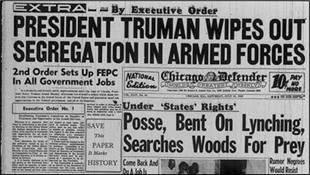 Reports of violence on Black military members and veterans after WWII deeply influenced President Truman’s perspective and compelled him to undertake civil rights reform. That transformation included his signing of Executive Orders 9980 and 9981 on July 26, 1948, aimed at desegregating the military and ending discrimination in the federal workforce.
Reports of violence on Black military members and veterans after WWII deeply influenced President Truman’s perspective and compelled him to undertake civil rights reform. That transformation included his signing of Executive Orders 9980 and 9981 on July 26, 1948, aimed at desegregating the military and ending discrimination in the federal workforce.
These executive orders were not unanticipated. In 1945, government studies were being conducted on the prospect of desegregation. During and after WWII, some venerated military leaders made clear their opposition to racial integration. As with other sweeping personnel reforms, objections to equality were cloaked in statements about readiness, aptitude, effectiveness, and morale.
Thoughts from military leaders
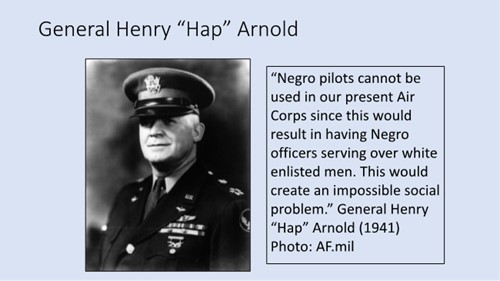 In 1940, Congress amended the Selective Training and Service Act to disallow race and color discrimination, essentially requiring the War Department to accept Black members proportionately. The Air Corps, which was the aerial warfare component of the U.S. Army, still resisted accepting African Americans to its Glenview, Illinois, training station. Black applicants were informed that the Corps lacked separate accommodations, therefore they could not be admitted. Air Corps chief, Gen. Henry “Hap” Arnold, reinforced this position, arguing that since no segregated Black units existed in the Corps, it had no aperture for accepting them.
In 1940, Congress amended the Selective Training and Service Act to disallow race and color discrimination, essentially requiring the War Department to accept Black members proportionately. The Air Corps, which was the aerial warfare component of the U.S. Army, still resisted accepting African Americans to its Glenview, Illinois, training station. Black applicants were informed that the Corps lacked separate accommodations, therefore they could not be admitted. Air Corps chief, Gen. Henry “Hap” Arnold, reinforced this position, arguing that since no segregated Black units existed in the Corps, it had no aperture for accepting them.
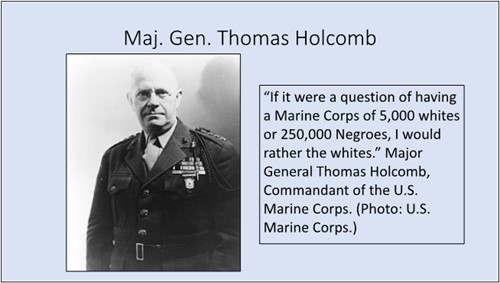 Maj. Gen. Thomas Holcomb, commandant of the U.S. Marine Corps, who did not support the all-Black Montford Point Marines, also did not support integration. When, in April 1941, the U.S. Navy General Board met to deliberate expansion of the Corps, he expressed the view that African Americans did not possess the right to serve as Marines.
Maj. Gen. Thomas Holcomb, commandant of the U.S. Marine Corps, who did not support the all-Black Montford Point Marines, also did not support integration. When, in April 1941, the U.S. Navy General Board met to deliberate expansion of the Corps, he expressed the view that African Americans did not possess the right to serve as Marines.
Some in leadership expressed views that Black people lacked the ability to be fighters and fighter pilots. Army Chief of Staff, Gen. George Marshall wrote a letter in 1941 stating that steps toward integration were dangerous. The year prior, he said that the military was not the domain to change policies on segregation, since the policies and practices were widespread in American society.
In 1941, U.S. Navy Adm. Chester Nimitz commented that integration would not be successful based on the expectation of friction. “One does not install a part in a machine, no matter how excellent that part may be in itself, unless it will fit and work smoothly with other parts. That, frankly, covers the Navy Department’s attitude on this question,” he said. 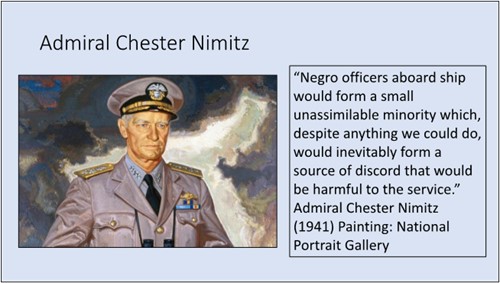
In January 1944, a Department of War memorandum stated, “The policy of the War Department is not to intermingle colored and white enlisted personnel. To make changes (on segregation) would produce situations destructive to morale and detrimental to the preparation for national defense.”
Some studies were showing that armed forces members who served interracially found that the experience rendered them more open and accepting. A 1945 survey polled 250 white officers and enlisted members to whom a segregated unit was assigned. It found that 77% of respondents’ views had become more favorable toward African Americans after serving with them. In no case did any respondents indicate that a less favorable shift in their views had occurred. Furthermore, 84% of the officers and 81% of the enlisted members expressed that the African Americans in their units performed very well in combat. The majority expressed the view that Black soldiers and white soldiers got along well. Surveys such as this defied many of the rationales being used to justify segregation in the military and offered contrast to the vocal, anti-segregation voices at the time.
Notwithstanding this research, in his April 1948 Testimony on Universal Military Training, Senate Committee on Armed Services, Gen. Dwight Eisenhower reinforced the view that integration should be avoided because from his perspective, it would cause friction, and limit the ability of Black people to “succeed.”
As military leaders made known their thoughts about segregation, the stark reality of its impact came to prominence through the harrowing incident experienced by African American WWII veteran Isaac Woodard.
An incident garners national attention 
The February 1946 attack on WWII veteran Isaac Woodard had a profound effect on President Truman. The Black veteran was emblematic of others who had fought domestically and overseas but were experiencing violent encounters as they returned from duty. Some Black active duty and veteran members had their uniforms and service status questioned as they attempted to interact in American society, often after experiencing acceptance outside of the U.S.
Woodard was pulled from a Greyhound bus as he, still in uniform, was on his way home to his family in Winnsboro, South Carolina, three hours after his honorable discharge from the U.S. Army. At a rest stop, Woodard and the bus driver had exchanged words when he requested time to use the restroom. When the bus arrived at the next stop in Batesburg, South Carolina, police were waiting. Woodard was taken from the bus, arrested and beaten so badly he was permanently blinded. At first, the incident received little attention, but the National Association for the Advancement of Colored People (NAACP) ensured its widespread coverage. Woodard’s experience had a galvanizing effect on the nation and foregrounded the civil rights movement.
With regard to treatment of returning Black service members, President Truman stated, “My stomach turned over when I learned that Negro soldiers, just back from overseas, were being dumped out of army trucks in Mississippi and beaten.” He further commented, “Whatever my inclinations as a native of Missouri might have been, as president I know this is bad. I shall fight to end evils like this.” The following year, Truman became the first American president to speak at the NAACP annual meeting. During his speech, he characterized civil rights as a moral priority, and identified the epoch as a turning point for guaranteeing equality to all American citizens. “When I say all Americans — I mean all Americans,” President Truman declared.
Segregation and the injustices faced by African American service members were occurring within a social climate of discrimination, lynching and mob violence being targeted to Black individuals and communities. Civil rights activism brought attention and awareness, leading the nation to take note and make strides toward reform.
A president takes action
President Truman needed African American voters, but moreover, his conscience told him that ending segregation was morally right and in the best interest of the United States. One of his first initiatives toward achieving this occurred in December 1946, when Truman established the Civil Rights Commission, a body that produced a report condemning discrimination and calling for an end to segregation. At great political risk, Truman asked a joint session of Congress to support the Committee’s recommendations including federal protection against lynching, but the proposal garnered strong opposition. Vacating the legislative strategy, Truman then applied his executive powers. On July 26, 1948, despite the objection of admired military leaders, he signed Executive Order 9980, which eliminated discrimination in federal employment, and 9981, which banned segregation in the U.S. armed forces. Both institutions could then more fully access the talent pool comprised of African Americans.
As President Truman signed Executive Order 9981, he renounced officially sanctioned discrimination policies that had stood for 170 years. While African Americans had served, they had almost always been in segregated units assigned to limited roles. Executive Order 9980 authorized review boards within federal agencies to which employees could bring claims of racially discriminatory treatment. The event stamps the first date on which a U.S. President used an executive order to implement a civil rights policy. The signing of these orders inspired other sectors to denounce segregation.
The orders did not set dates and timeframes or require plans for integration and non-discrimination, and as such, it would be decades before these outcomes were achieved. The U.S. Air Force was desegregated by 1952, while the Army dissolved the last segregated unit in November 1954. The action not only broadened employment prospects but was transformative in how African Americans started to be viewed in the United States.
Reflections on the 75th anniversary by the Coast Guard’s first African American flag officer 
In 1955, the Coast Guard Academy admitted its first African American cadet, who despite stellar performance, resigned two years later due to a serious health condition. Seven years later, the institution admitted Merle Smith, who in 1966, became its first graduate. During this era, the Coast Guard also enrolled Erroll M. Brown, who graduated in 1972 with a degree in marine engineering. Brown later rose through the service ranks, and in 1998 became the first Black flag officer in the service’s history.
Military desegregation unfolded through the early 1950s as many other sectors remained segregated. Public education, for example, was not desegregated until 1954 with the landmark Brown v. Board of Education Supreme Court decision. The court did not include a date, thus implementation rolled out slowly and was not complete in Brown’s home state of Florida until 1972. In consequence, young Erroll Brown lived the experience of desegregation as a 10th grader when his mother told him he was going to be enrolling in a different school. Brown was in the second class of Black students who entered a previously all-white school.
An early African American at the Coast Guard Academy
After receiving a postcard from the Coast Guard Academy, Brown responded and was offered admission. As he looks back on his entry into the Academy, he can recall interactions that were clearly racial. “A lot of people experienced the sort of treatment designed to get you kicked out, and mine had a racial tone. But they didn’t succeed in what they wanted,” he said.
Into the fleet
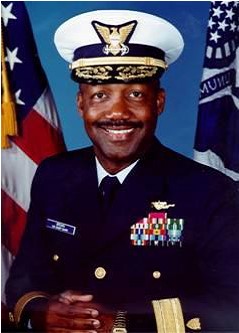 After graduation, as one of few Black officers at the time, Brown encountered situations that others did not. Once, when he was on official travel, driving in the deep South, roads narrowed, and he noticed traffic slowing ahead. He soon saw the reason. People wearing white pointed hoods and robes, members of the racial hate group the Ku Klux Klan, stood at the intersection ahead, talking to motorists, distributing leaflets, and collecting donations for their cause. He could not turn around and spent a harrowing several minutes with his pulse racing figuring out what to do. Affirmations, prayer and sheer luck converged when the traffic light turned green, and he flowed through the intersection without having to stop and encounter the group. These and other reflections underscore for Brown the importance of diversity throughout an organization so that the experiences felt by members can be understood, affirmed and their military or public service supported.
After graduation, as one of few Black officers at the time, Brown encountered situations that others did not. Once, when he was on official travel, driving in the deep South, roads narrowed, and he noticed traffic slowing ahead. He soon saw the reason. People wearing white pointed hoods and robes, members of the racial hate group the Ku Klux Klan, stood at the intersection ahead, talking to motorists, distributing leaflets, and collecting donations for their cause. He could not turn around and spent a harrowing several minutes with his pulse racing figuring out what to do. Affirmations, prayer and sheer luck converged when the traffic light turned green, and he flowed through the intersection without having to stop and encounter the group. These and other reflections underscore for Brown the importance of diversity throughout an organization so that the experiences felt by members can be understood, affirmed and their military or public service supported.
When asked what can be taken from the segregation and desegregation chapter in armed forces history, Brown recognized that it was because of people who toiled and sacrificed in the United States armed services and in his community, that he could occupy the roles he held. Brown regards the Truman executive orders — and even the more recent calls for justice for Mr. George Floyd that occurred in the public square during 2020 — in the same context of people who participated in bussing to achieve school integration. He remarked,
They sat on busses and carried their hopes and dreams with them, not always aware of what was waiting for them. It is up to those who are in power, who do have knowledge of the situation and possess an influential voice, to ensure that each of our workforce members’ hopes and dreams, along with mission, are fulfilled.
The government’s modern-day horizons for equality
While the demographics of today’s military and civilian workforce have advanced from yesteryear’s, data suggests that participation at upper ranks, rates and grades are the new horizons. African Americans comprise 12% of the U.S population, but 8% percent of active-duty officers and, for most services, a smaller percentage of flag officers.
In government civil service, 61% of the workforce is white and 18.2% is Black, yet the government’s senior executive service is 75.7% white and 11.7% Black. Structural and cultural norms are often cited as hindering.
Opportunity remains for military and government agencies to set meaningful workforce development and upward mobility objectives. Success strategies in diversity must include preparing the workforce to expect diverse leadership, who possess attributes that personnel may not have previously encountered. Provision of sponsorship and support to African Americans and other minoritized individuals — in the form of advocacy, visible assignments, and connections — are also paramount in achieving their progression to upper and senior ranks.
Remembering President Truman’s actions of 75 years ago offers an opportunity for our nation to understand the relevance of segregated African American troops and civil servants, not just to Black history but to American history. It symbolizes the triumph of the collective human spirit over forces that malign and divide. It stands as a testament to the goal of equal rights for all. The occasion is as much about the imperative of inclusion as it is about the perniciousness of withholding it.
Dr. Terri A. Dickerson is civil rights director for the United States Coast Guard and the first African American woman to serve in its senior executive service. Mr. Patrick Ferraris, a former U.S. Army broadcast journalist, is communications specialist for the Civil Rights Directorate at the Coast Guard.